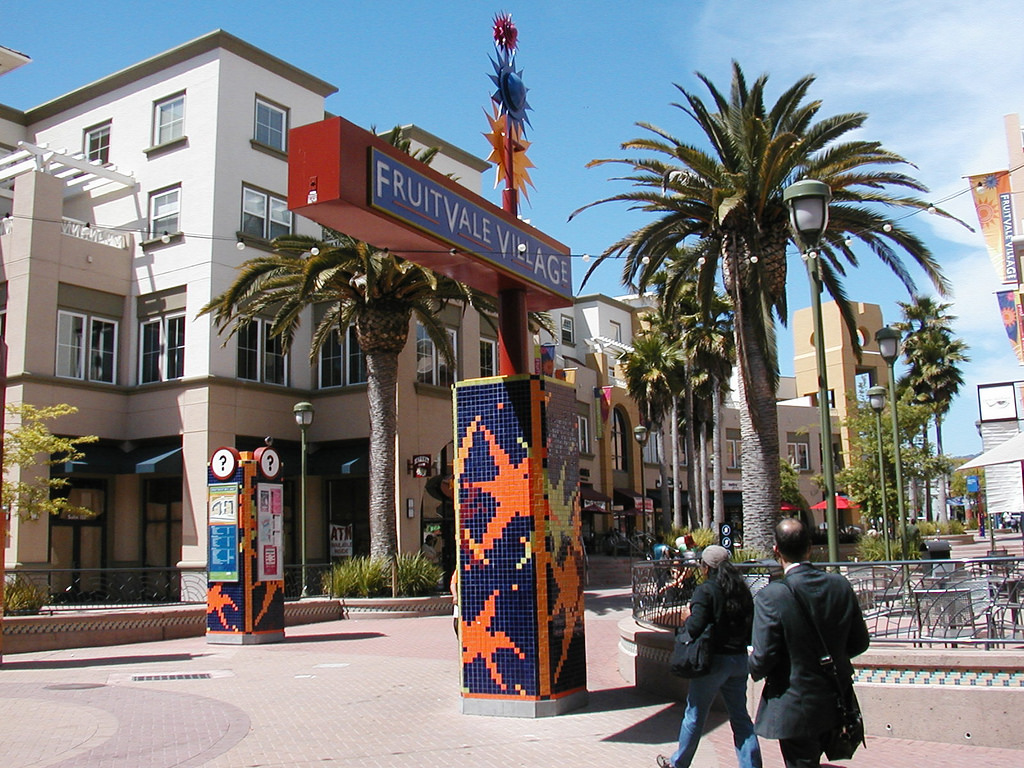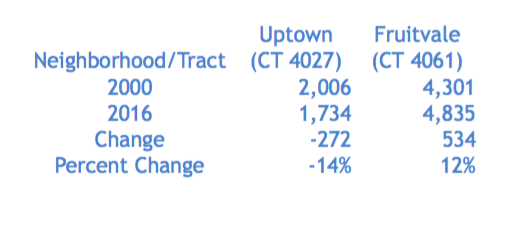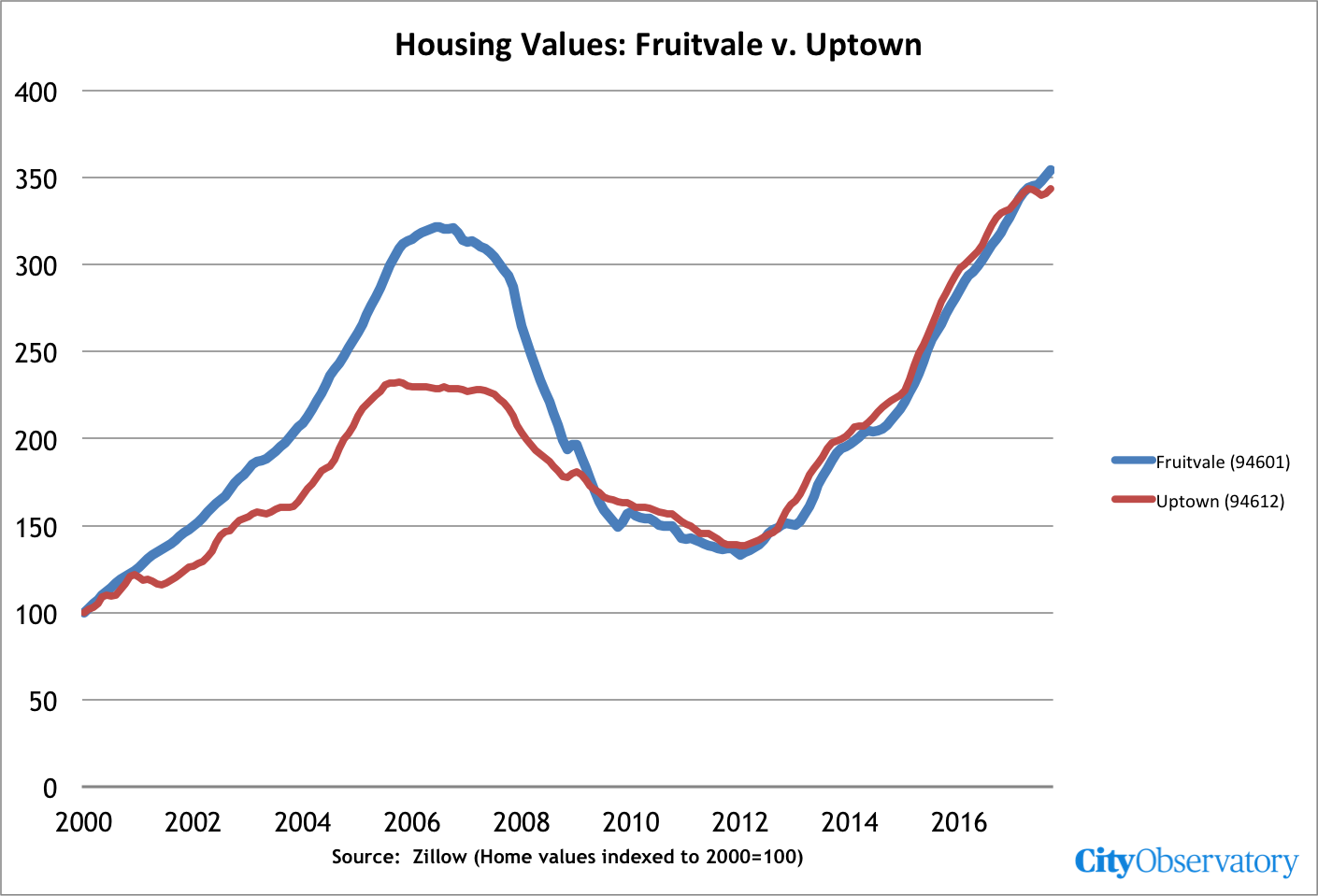What does Fruitvale tell us about gentrification and displacement?
Gentrification solved, or at least prevented.
That was the celebratory headline announcing a recent study from UCLA’s Latino Politics and Policy Initiative, looking at changes in Oakland’s Fruitvale neighborhood. Fruitvale, a predominantly Latino neighborhood, the site of a transit-oriented development (TOD) at its BART rapid transit station. The report notes that the 47-unit TOD project included 10 units of affordable housing (more are planned), and that since 2000, the share of the neighborhood’s population that is Hispanic according to census data has remained essentially unchanged. The study, and the media reporting on it, are ready to call this a success story in preventing displacement.
The San Jose Mercury News lead with: “Development without gentrification? Oakland’s Fruitvale is the model, report says.”
CityLab‘s headline crowed: “How Transit Oriented Development Can Prevent Displacement”
The full study “Should I stay or should I go: How effective transit oriented development can lead to positive economic growth without displacing Latinos” makes the same argument:
This study found that the Fruitvale Village TOD increased the economic well-being of residents in the immediate neighborhood while preserving the area’s diverse racial/ethnic diversity. . . . .
The Fruitvale census tract outperformed similar neighborhoods in the region and the state as measured by:
. . . reduction in residents without a GED/high school degree, increase in residents with B. A. completion, increase in the number of residents who own homes and increase in resident’s median household income.
So does Fruitvale’s Transit Oriented Development show a sure fire way to prevent gentrification? We’re not so sure. A closer look shows that the evidence of what happened is less clear and more complicated that suggested by these claims. It challenges us to be explicit about how we define gentrification, and to confront the serious limitations in trying to measure displacement with existing data. The data shows that the economics trends that produced higher rents and home values were felt almost exactly the same in neighborhoods that the study described as “gentrifying” and “non-gentrifying,” suggesting that larger regional forces are at work. And within the neighborhoods, it appears that expanded housing supply played a key role in minimizing measured demographic change.
What do we mean by gentrification?
Let’s take a closer look at this narrative of success. Before we can determine whether a neighborhood has prevented or avoided gentrification, we have to have a clear definition of what the word gentrification means. If we mean rising housing costs that force people of limited means to sell, or become even more rent-burdened, then what’s happened in Fruitvale hardly looks like a cure for the economic effects of gentrification (more on that below). If by gentrification we mean, the overall racial/ethnic composition of the neighborhood changes very little, then at least on its face, the study makes a fair claim.
The “displacement prevented” conclusion in the UCLA study hinges on the very small overall change in the Latino share of population of Fruitvale between 2000 and 2015. But the key word here is “overall.” What the data really can’t do is tell us much about who moved in and out of the neighborhood. We can tell that the fraction of Latinos changed very little, but we don’t know whether low and moderate income Latinos were replaced by higher income or better educated Latinos. That’s the assumption, but there’s simply no evidence either way, because the data (drawn from the American Community Survey) is really just a comparison of somewhat blurry, point-in-time snapshots, rather than a longitudinal tracking of individual people over time. To their credit, San Jose Mercury News acknowledged this challenge in their story:
Nor is it clear the existing residents are the ones benefiting from higher incomes and better educational attainment, and not new, wealthier residents with a similar demographic profile, who are displacing their low-income counterparts, said Robert Cervero, professor emeritus of city and regional planning at UC Berkeley.
Undoubtedly some of the long term residents of the neighborhood completed additional education and got better paying jobs, but it’s likely that much of the measured increase in both educational attainment and income has to do with new residents moving in having higher wages and more extensive education than those who moved out. But the trouble is ACS snapshot data can’t definitively answer that question.
A tale of two diverse neighborhoods: Fruitvale and Uptwon
The core of the UCLA study is based on a comparison of two Oakland neighborhoods, Uptown and Fruitvale. Uptown is a plurality African-American neighborhood just north of downtown Oakland, while Fruitvale is, as we’ve noted, a predominantly Latino neighborhood a couple of miles south of Oakland’s downtown.

According to the UCLA study, Fruitvale didn’t gentrify, but Uptown Oakland did. That conclusion seems to be based on the observation that the fraction of persons of color in Fruitvale remained basically unchanged, while the fraction of persons of color in Uptown declined. As the report says: “Between 2000 and 2015, Census Tract 4027 [Uptown] experienced a sharp decrease in their residents of color compared to the more muted changes experienced by the Fruitvale Village TOD.” The white non-Hispanic share of the Uptown population increased from 3.7 percent to 27 percent; the white non-Hispanic share of the Fruitvale population decreased by four-tenths of one percentage point, from 11.9 percent to 11.5 percent.
Clearly, Uptown got “whiter” compared to Fruitvale. But in 2015, whether they are labeled as “gentrified” or not, both of these neighborhoods are extremely diverse. As measured by the racial/ethnic diversity index, Uptown is more diverse than 90 percent of all urban neighborhoods in the US, and Fruitvale is more diverse than 66 percent of all urban neighborhoods. If, as Ruth Glass defined gentrification when she coined the term in 1964, gentrification constitutes a neighborhood is invaded and newcomers move in “until all or most” of the previous occupants” are displaced, it’s far from clear that either of these neighborhoods is gentrified (as measured by race and ethnicity).
It’s also important to examine the population change in these neighborhoods in the context of the broader demographic trends in the Bay Area. According to the Bay Area Equity Profile, compiled by PolicyLink from US census data, the black population of the Bay Area decreased by about 8 percent between 2000 and 2013, while the Latino population increased by 33 percent. Given the region-wide decline in the black population, and the region-wide surge in Latinos, it is less remarkable that plurality black Uptown saw a decline in its population of color. The fact that Fruitvale’s Latino population share declined slightly at a time when the region’s Latino population increased by a third suggests that Fruitvale’s Latino population growth underperformed the regional trend.
Fruitvale home values went up just as much as in “gentrifying” Uptown
By most accounts, rising home values are a hallmark of gentrification. As home values and rents rise (and they tend to move in tandem as neighborhoods change), lower income families find it more difficult to afford housing in the neighborhood. Some families may be “forced” to move out by higher prices. (We put the word “forced’ in quotes, at least for homeowners, because higher prices also imply a big financial gain for those who sell their homes). The manner of how someone comes to leave their neighborhood is much debated, particularly because homeowners can experience big financial gains when prices rise. Renters who choose to stay in the neighborhood experience higher rents.
Let’s take a look at price trends in the two neighborhoods, based on Zillow’s estimates of housing prices for the the two zip codes that correspond most closely to Fruitvale (94601) and Uptown (94612). The following chart shows home prices in the two neighborhoods indexed to year 2000 values (the base year of the UCLA study). For most of the past decade, price trends in the two neighborhoods are almost identical. The housing bubble of the mid-aughts was more pronounced in Fruitvale, but since 2009, there’s virtually no difference in price trends between the two neighborhoods.
These data suggest that real estate market forces were very similar in these two places. In part, this reflects the regional nature of housing markets: the Bay Area is very hot, and housing prices are going up throughout the area. (Home prices have roughly doubled in the past five years). But in particular, since 2009, price trends in gentrifying Uptown and non-gentrifying Fruitvale have been indistinguishable. If there’s been a difference in the nature of population change between these two neighborhoods, it doesn’t appear to attributable to differences in housing cost inflation.
Housing supply, population growth and displacement
There’s one salient difference between the “gentrifying” Uptown neighborhood and the “non-gentrifying” Fruitvale neighborhood: housing construction. As a quick look at Census data for the two tracts shows that since 2000, 554 units of new housing have been built in Fruitvale (Tract 4061), and just 56 in Uptown (Tract 4027). The following table from Census Reporter shows the American Community Survey estimates of the number of housing units by the year built (estimates are followed by the survey’s reported margin of error).
The effect of these new units is reflected in the population counts for the two census tracts as well; Fruitvale’s tract 4061 saw a net gain of more than 500 residents since 2000, while Uptown’s tract 4027 experienced a decline in population of more than 250 residents.

This data gives us one possible basis for explaining the relatively lack of racial/ethnic change in Fruitvale compared to the more significant racial and ethnic change in Uptown. Building more housing in Fruitvale may mean that fewer Latino families moved out. As we’ve reported at City Observatory, the larger studies of the Bay Area housing market (undertaken by the Legislative Analyst and Chapple and Zuk) find that there’s a negative correlation between the construction of additional market rate housing and measures of displacement: neighborhoods that build more housing have less displacement. If Fruitvale has found an answer for gentrification (or at least its aggregate ethnic or cultural aspects), it may have done so by building housing–and not just the relative handful of affordable units, but by a much larger increase in the number of market rate units. Constricting the supply of housing tends to turn neighborhood change into a zero-sum game, where higher income households can outbid lower income households for the limited number of places to live. The key to avoiding displacement is building more housing.
If the Uptown/Fruitvale comparison has a lesson to teach us about displacement, it’s this: If you you build more housing in a neighborhood, you can accomodate more people, and demographic change is likely to be slower. If you don’t build housing, you make neighborhood change a zero-sum game, and likely accelerate displacement. It’s also a reminder that housing markets are regional: rents and home prices rose by almost exactly the same amounts in both neighborhoods. Unless the entire Bay Area figures out a way to build more housing, the affordability problem is bound to worsen, with the greatest negative effects being felt by low income renters.
The takeways
The tale of two neighborhoods, Fruitvale and Uptown, sheds a useful light on the way we talk about gentrification, neighborhood change and housing affordability.
- Just because the overall racial/ethnic composition of the neighborhood didn’t change much since 2000 doesn’t necessarily mean that there wasn’t considerable churn and displacement of previous lower income residents with newer higher income residents.
- If you want to reduce displacement, build more housing. Neighborhoods that don’t expand their housing supply are more likely to experience displacement.
- You can’t ignore the larger regional context: growing demand for urban living, coupled with a limited and slowly growing supply of housing in urban neighborhoods generates higher home values and rents throughout the region.


